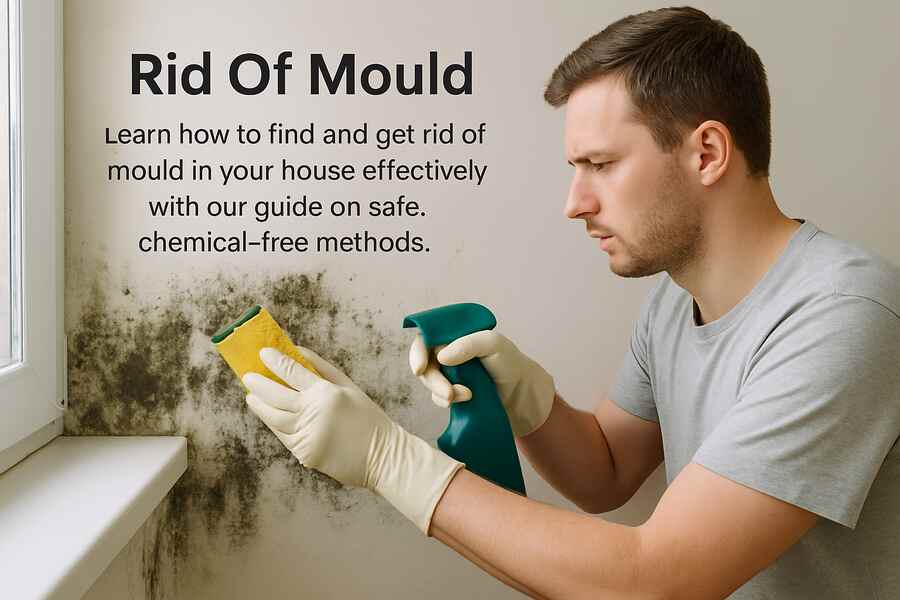Rid Of Mould: Safe Ways to Clean Your Home Naturally
Have you ever woken up to see some strange stains on your walls or that damp musty smell that persists? It may even be mould creeping through your house. Mould is furtive (it lurks in moist corners, behind pieces of furniture and even in walls) and can all too easily be overlooked until it has become a major issue.
Don’t worry, though, there is no need to start getting frantic or dial the experts yet. A bit of knowledge will enable you to detect places where mould is lurking and what can be done to eliminate it safely. It can be hanging around the bathroom, the kitchen or the basement, but you want to know how we can find how to get rid of this. Willing to reclaim dominance of your space and breathe a sigh of relief?
How to Find and Get Rid of Mould in Your House?
This blog provides causes, symptoms and safe, chemical-free methods to eliminate and avoid mould that can be used by seeking assistance from Bond cleaning Perth professionals. Mould is not only a problem to be solved on the surface, but it also impacts air quality and causes allergies. It is very quick to spread when ignored and can be found in damp areas such as the kitchen and bathroom.
1. Wash In Soap And Warm Water
Removing mould and fungus encountered in the initial stages can be easily done without permanent marks being left behind. Begin with a rudimentary soap solution of soap and warm water. Clean the area with a circular motion with the use of a microfiber cloth or a soft brush. Cleaning around the visible mould at least 50 cm is recommended by professional end-of-lease cleaners because spores may extend more than what can be seen by the naked eye. This practice is non-offensive to most surfaces, and it is a fantastic place to start.
2. Apply straight Cleaning Vinegar
Cleaning vinegar, which is 6 per cent acetic acid, is an excellent natural mould killer. Apply it directly to the area that is affected area and leave it there for about one hour. In case it is already dry when that time arrives, reapply. After that, remove the residue with a paper towel the residue. Afterwards, you may as well wash with soap and water to sanitise the area further and get rid of any residual smell of vinegar.
3. Use Baking Soda & Dishwashing Liquid Paste
When dealing with hard-to-remove mould on tiles and grout lines, and sinks, combine baking soda with dishwashing liquid to create a paste. Baking soda scrubs and dish soap cleans through the grease. Spread the paste on the area, and leave it for 30 and 45 minutes. With a soft brush, scrub them, wash them off with warm water, and repeat as needed.
4. Use 3% Hydrogen Peroxide to Get Rid of Mould
The other solution that kills moulds and fungi is hydrogen peroxide. Combine it with slightly less cream of tartar to give it a greater efficacy, and wet the mouldy surface with it. Leave to rest at least 10 minutes, scrub, rinse with soap and water. Alternatively, it may also be combined in a 50/50 ratio of water and hydrogen peroxide.
5. Lemon Concentrate Sanitise
Similar to vinegar, lemon juice is acidic and may dissolve mould with a pleasant fresh citrus smell. Rub the affected area with lemon concentrate directly and scrub. Do a swatch test on an inconspicuous location before bleaching or ruining more sensitive surfaces.
6. Anti-Fungal Essential Oils
Tea tree, citronella, lemon, eucalyptus, and peppermint are very effective natural mould knockers. Add 5-10 drops to 300 500ml of water or vinegar and spray them on the affected surfaces directly. Soak it for an hour, and finally clean it with soapy water. Essential oils are among the most common professional End-of-lease cleaning products. Due to the increased cleaning effect and pleasant odour that they produce.
7. Ventilate Properly
Mould and mildew grow in poorly ventilated, damp and dark areas. Inhibit and control growth by enhancing ventilation. Open windows, turn on ceiling fans or exhausts and use natural light. This action minimises moisture to a great extent, inhibiting mould and fungus.
8. Put Camphor Balls in Wardrobes
Humid conditions also favour mould in damp carpet items. An easy preventive step is replacing gunny bags of camphor balls inside. Camphor is aromatic, non-toxic and possesses natural anti-fungal properties, an advantage over chemical-based products such as naphthalene balls.
9. Steam Cleaning
Steam above 100Uc can destroy mould, bacteria, and viruses because of contact with it. It is an efficient, chemical-free solution to sanitising tiles, walls, floors and even fabrics. It is one of the least harmful methods, as all you require is a steam cleaner of good quality and clean water.
10. Give Grapefruit Seed Extract a try
This concentrated natural cleaning agent is full of antioxidants and is marvellous against mould and mildew. Put a few drops in water, spray into the affected region and allow it to remain for 10-15 minutes. Clean the surface with a scrub and then remove it and apply it again. Air-dry it to prevent regrowth.
Wrapping Up
Wherever mould and fungus grow in your house, this is a health risk, and it will cause many problems like asthma, headaches, chronic respiratory diseases and many more. They also damage the structural integrity of surfaces and fixtures, i.e. mould, mildew, or fungus in your rental property is a serious problem. Mould can readily grow undetected to cause severe health problems when ignored. In each household, it is crucial to identify the early signs and eliminate them properly. Such preventive procedures, including adequate ventilation and cleaning, are also required. In the event that you cannot clear after having done both the natural and chemical cleaning, you should always consult a professional. Making the right move at the opportune moment would guarantee a risk-free and hygienic indoor environment.


